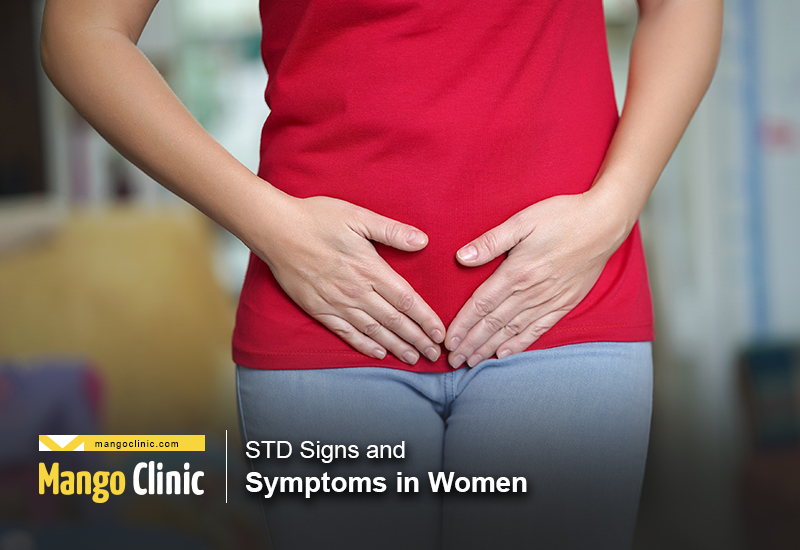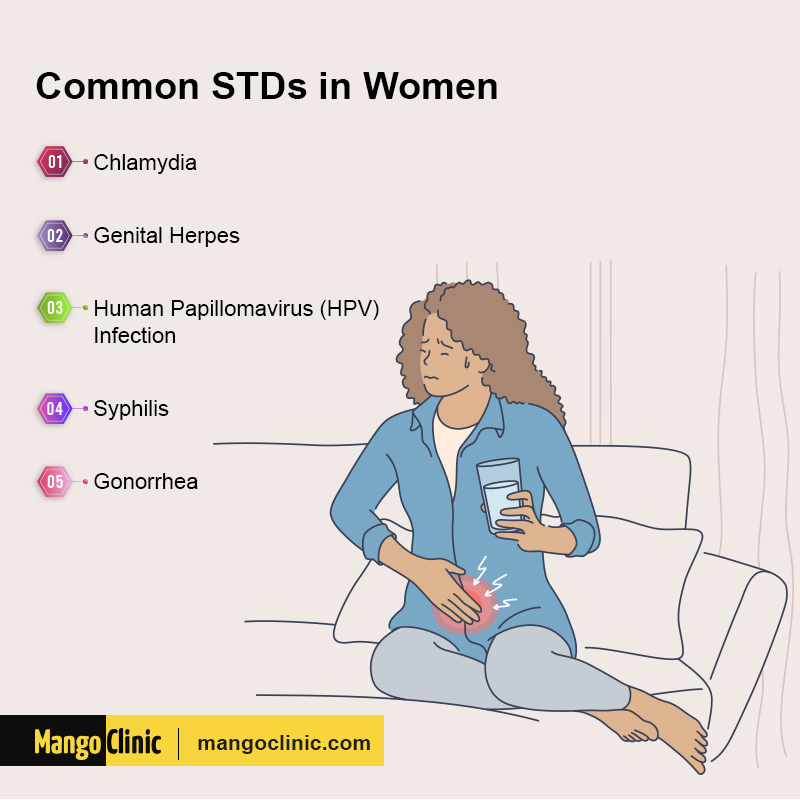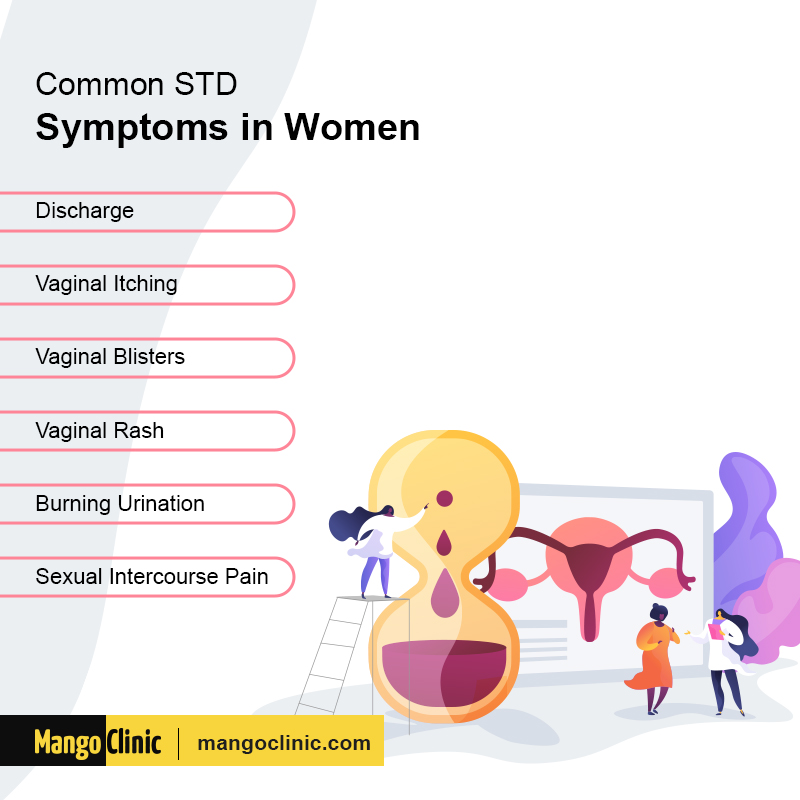STD Signs and Symptoms in Women

One of the significant concerns in women’s health today is the spread of Sexually Transmitted Infections (STIs) and Sexually Transmitted Diseases (STDs). Though the terms are often used interchangeably, they are quite different. STIs are the more than 25 identified infections that are spread by sexual contact with infected individuals. STDs, on the other hand, are diseases that can result from infections. For example, the Human Immunodeficiency Virus (HIV) is the infection that causes Acquired Immunodeficiency Syndrome (AIDS). AIDS is a sexually transmitted disease. Both STIs and STDs are caused by viruses, bacteria, or parasites and are passed from one person to another during sexual contact. Vaginal, anal, and oral sex can spread these dangerous infections. Though abstinence is the only sure way to prevent the spread, condoms and other prophylactics can help limit a person’s chances of infection when used correctly.
Get proper treatment for sexually transmitted diseases. Click the button below to book your appointment.
The World Health Organization (WHO) reports that a staggering one million people are infected every day with an STI worldwide. Unfortunately, the United States is believed to have the highest rate of infections in the developed countries with approximately, 20 million new cases each year. Half of all reported cases in the US can be found in young adults ages 15-24.
The overwhelming rate of teenage infection may be the result of several factors. Not only are teenage girls less likely to consult a medical professional for advice before engaging in sexual activity, but they are also less likely to have access to prophylactics. Additionally, teenage girls and young women are more at risk for STDs because their cervixes are lined with cells that are more likely to become infected. Visit Mango STD Clinic in Miami for more help.

How Serious Are STIs?
If left untreated, these infections can lead to serious health concerns including cancers, liver disease, pelvic inflammatory disease (PID), infertility, and even death. A number of these infections can also affect your immune system if not aggressively treated and could increase your chances of being infected if exposed to HIV. Unfortunately, many people have sexually transmitted infections that are not aware of their condition. STIs can be passed on to others even though symptoms are not present.
Many STIs are treatable with strong antibiotics, but there are others that are not curable. HIV and Herpes are two infections that have no known cures although treatment to manage the conditions have been developed.
STIs can be either bacterial or viral. Viral infections can lead to death when undiagnosed and untreated. Those that affect the whole body are often more serious and are likely to have gone from the infection stage to the disease stage. They can cause symptoms that are often described as a horrible case of the flu with symptoms such as body and muscle aches, fever, rash, and headaches before leading to dramatic and often deadly amounts of weight loss.
Get yourself treated for STIs. Click the button below to book your appointment.
Symptoms of an STI or STD in Women
If you are sexually active, it is essential to have regular health screenings. Some STIs mimic other illnesses and can be easily misdiagnosed if patients are unwilling to have an open and honest conversation with their health care provider. Doctors do not routinely order testing for STIs unless a patient acknowledges sexual activity. This misinformation can result in ineffective treatment and lead to more severe complications.
Symptoms of some STIs can be seen as early as two days, or they may take several weeks to appear. Unfortunately, some women may not have any symptoms until the infection is in advanced stages. Although it is possible to spread infections without having symptoms, when they do occur, they are generally seen in the genital area. If you are engaging in oral or anal sex, the mouth, throat, upper thighs, anus and even the eyes can also be impacted by these infections.
Common symptoms that may be seen in female:
- Vaginal itching
- Bumps, warts, rash, lesions, or sores around the genital area
- Unusual vaginal odor
- Pain during sex
- Pelvic or lower abdominal pain
- Rectal discharge, bleeding or pain
- Unusual discharge
- Burning sensation while urinating
- Frequent urge to urinate

Ways to Protect Yourself and Others from STD
Unless individuals practice abstinence, the only other way to reduce the risk of contracting a sexually transmitted infection is to use proper precautions. Condoms are available for both men and women and should be used for the entire sexual encounter not just during penetration. It is also important to understand which product to use and when. The list below is a useful guide to follow.
- Latex condoms should be used for vaginal and anal sex (plastic if sensitive to latex)
- Use Latex or plastic barriers such as dental dams for oral sex with women and nonlubricated condoms for men
- DO NOT use oil-based products because they destroy latex (water-based are suitable)
- Wash shared sex toys and utilize condoms between users
- DO NOT use products that contain nonoxynol-9 (damages the lining of the vagina or anus)
- Birth control pills, shots, implants nor diaphragms offer any protection from STIs or STDs
One of the best ways to prevent the spread of STIs and STDs is to have routine screenings if you are sexually active. Knowing your status and that of your partner or partners and using the proper methods to prevent transmission will help ensure the safety of yourself and others.
It is also important to know that STIs and STDs can be transmitted to your unborn child during pregnancy or delivery. To protect the health of your child talk to your doctor about testing, treatment, and precautions to take if you are pregnant or planning on becoming pregnant.
Protect yourself from sexually transmitted diseases. Click the button below to book your appointment.
STD Testing in Miami
Testing for STIs can be quite simple. Blood and urine samples are often commonly used for detection. If you participate in oral or anal sex additional testing is required. While Rapid Results testing can offer results within a few hours, not all tests can be performed this way; some may take up to 2 weeks. Although this delay can be somewhat frustrating, it’s important that comprehensive quality testing is completed, and the right course of treatment prescribed if results are positive.
If you live in the Miami area and are sexually active, the caring and discrete professionals at Mango Clinic are ready to assist you. The experienced medical team will be with you every step of the way providing services from STD testing, diagnosis, treatment, and recovery support. Located at 434 SW 12th Ave Suite 205, Mango STD Clinic is open Saturdays and Sundays. Call today +1(786) 422-9327.
Contact Us at Mango Clinic for STD and STI treatment or click the banner below to book your appointment.





